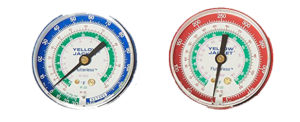
Summary of Knowledge Required for the Low-Pressure Examination
Detecting Leaks:
-
Know the preferred order of pressurization methods for leak-testing low-pressure refrigeration systems.
- Hot-water method. (Or built-in system heating equipment)
- Nitrogen testing method.
- Know the signs of leakage into a low-pressure system. For example excess purging.
- Know the maximum pressure for leak-testing low-pressure centrifugal chillers.
- Know the leak-inspection requirements for appliances that are exceeding the accepted leak rate.
- Know the reporting requirements for chronically leaking appliances.
Leak Repair Requirements:
- Know the allowable annual leak rate for commercial and industrial refrigeration.
- Know the allowable annual leak rate for other appliances with over 50lbs of refrigerant.
Recovery Techniques:
- Know that recovering liquid refrigerant at the beginning of the recovery process helps speeds up recovery.
- Know that you need to recover the refrigerant vapor as well as the liquid refrigerant.
- Know that before removing the system oil it needs to be heated to 130 F to minimize refrigerant release.
- Know that you need to circulate or remove the water from a chiller during refrigerant evacuation in order to prevent freezing.
- Know the high-pressure safety cutout level of recovery devices used for low-pressure appliances.
Recharging Techniques:
- Know that you need to introduce refrigerant vapor before refrigerant liquid to prevent freezing of water in the tubes.
- Know that you need to charge centrifugal systems through the evaporator charging valve.
Recovery Requirements:
-
Know the refrigerant evacuation requirements for low-pressure appliances in each of the following situations:
- Evacuation requirements for disposal of appliances and components.
- Evacuation requirements for major repairs and what defines a major repair.
- Evacuation of leaky versus non-leaky appliances.
- Evacuation requirements for appliances or components containing less than 200 pounds of refrigerant versus those containing more than 200 pounds of refrigerant.
- Evacuation requirements using recovery and recycling equipment built before November 15th 1993 versus using equipment built after November 15th 1993.
- Know the definition what major and non-major repairs are in terms of evacuation/recovery requirements.
- Know the allowable methods for pressurizing a low-pressure system for a non-major repair (controlled hot water and system heating/pressurization)
- Knowledge of the need to wait a few minutes after reaching the required recovery vacuum to see if system pressure continues to rise, indicating there is still liquid refrigerant in the system or in the oil.
Refrigeration:
- Know what the purpose of purge unit in low-pressure refrigeration systems.
- Know the pressure-temperature relationships of low-pressure refrigerants.
Safety:
- Know the equipment room requirements mandated by ASHRAE Standard 15 requires an oxygen deprivation sensor with all refrigerants.
- Knowledge that under the ASHRAE Standard 15, equipment rooms also are required to have a refrigerant sensor for R-123.
Type 3 Low-Pressure Practice Tests
Type 3 Test 1
Type 3 Test 2
Type 3 Test 3
608 Navigation
BACK to Certification Types
BACK to EPA 608 General Info
BACK to HVAC Tech Page
